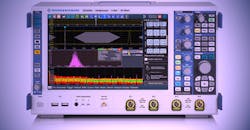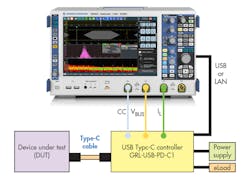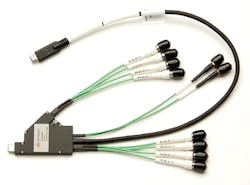The USB Implementers Forum (IF) brought the high-speed USB Type-C connector to the world. It has many advantages, including being reversible and sporting advanced power management that allows cables to deliver more power in addition to managing the power source. The new Fast Role Swap feature makes it possible to switch power sources in a multiple-device configuration that might include a combination like a docking station/hub, display, smartphone, keyboard, and mouse. The first three could be a power source.
Likewise, USB Type-C cables are a bit smarter than the current run of USB 2.x compatible cables that is just a set of wires and connectors. Embedded in a Type-C cable can be a controller that lets the source and drain know what the cable is capable of handling since the specification goes up to 100 W. Most cables will likely support much less. The USB 3 standard upped the power from 2.5 W to 4.5 W (900 mA at 5 V). That is well short of the 100 W possible with Type-C.
Of course, making sure a source or cable does not allow other devices to be fried is a good idea, so advanced test tools and reference designs help developers make sure things work properly.
Kevin M. Jones, director of marketing and applications at Texas Instruments (TI), notes, “Compliance testing is a key requirement for many of our customers to ensure interoperability and a great user experience. TI has created the required infrastructure to allow customers to quickly set up and run USB-C/PD compliance testing. TI has also created reference designs to aid customers in testing complex interoperability and power design. The USB Type-C and Power Delivery Multiport Adapter Reference Design allows a user to test the complex power transition required for Fast Role Swap, a key feature enabled in the latest PD 3.0 standard.”
Granite River Labs developed the Compliance Test Software and the USB Type-C Test Controller Hardware (Fig. 1). These are available from Keysight, Tektronix, Rohde & Schwarz, and Teledyne LeCroy with the software running on digital oscilloscopes that can analyze the Type-C protocols.
Granite River Labs developed the Compliance Test Software that runs on oscilloscopes from Keysight, Tektronix, Rohde & Schwarz, and Teledyne LeCroy. The USB Type-C Test Controller Hardware ties everything together.
The channel configuration (CC) pins are used to manage the power distribution. The CC is independent of the data channel that supports the USB 2.x and USB 3.x as well as alternate protocols like DisplayPort and MHL. The CC support manages the latter as well.
Type-C test fixtures like Keysight Technologies’ N7015A (Fig. 2) are needed to expose all the Type-C pins including power, CC and data.
Keysight Technologies’ N7015A Type-C High-Speed Test Fixture enables debugging of USB 3.1, DisplayPort 1.3, Thunderbolt 2/3, and MHL 3.3/SuperMHL connections.
Jit Lim, product manager at Keysight Technologies, says, “The Type-C connector in conjunction with USB-PD (Power Delivery) brings wonderful capabilities to the USB ecosystem. In addition to electrical testing, it is very important to consider Safety Testing of Type-C power management. This is because USB-PD provides up to 100W capabilities. Keysight provides a complete set of characterization, debug, compliance and Safety testing solutions for USB-PD.”
Developers will need the full spectrum of digital oscilloscopes and power diagnostic equipment when working on new USB Type-C devices. Compliance testing is even more important with Type-C compared to USB 2 and 3 because of power issues.
A low-cost option for just checking the CC protocol is Cirrus Logic’s CY4500 EZ-PD Protocol Analyzer (Fig. 3). The device is a pass-through for the high-speed communication, but it monitors the CC lines. The PC application analyzes the capture data and developers can view it in trace mode.
Cirrus Logic’s CY4500 EZ-PD Protocol Analyzer taps the CC lines to capture and trace the Type-C CC protocol. It acts as a pass-through for high speed data.
The Type-C connector and cables promise a more flexible wired-device connectivity than the popular USB connections have delivered. The added solution complexity is matched by the increased control complexity that has been added to the mix. Proper operation will only be had with compliant and compatible cables and devices. Developers will be able to deliver that with the proper tools.
About the Author
William G. Wong
Senior Content Director - Electronic Design and Microwaves & RF
I am Editor of Electronic Design focusing on embedded, software, and systems. As Senior Content Director, I also manage Microwaves & RF and I work with a great team of editors to provide engineers, programmers, developers and technical managers with interesting and useful articles and videos on a regular basis. Check out our free newsletters to see the latest content.
You can send press releases for new products for possible coverage on the website. I am also interested in receiving contributed articles for publishing on our website. Use our template and send to me along with a signed release form.
Check out my blog, AltEmbedded on Electronic Design, as well as his latest articles on this site that are listed below.
You can visit my social media via these links:
- AltEmbedded on Electronic Design
- Bill Wong on Facebook
- @AltEmbedded on Twitter
- Bill Wong on LinkedIn
I earned a Bachelor of Electrical Engineering at the Georgia Institute of Technology and a Masters in Computer Science from Rutgers University. I still do a bit of programming using everything from C and C++ to Rust and Ada/SPARK. I do a bit of PHP programming for Drupal websites. I have posted a few Drupal modules.
I still get a hand on software and electronic hardware. Some of this can be found on our Kit Close-Up video series. You can also see me on many of our TechXchange Talk videos. I am interested in a range of projects from robotics to artificial intelligence.





